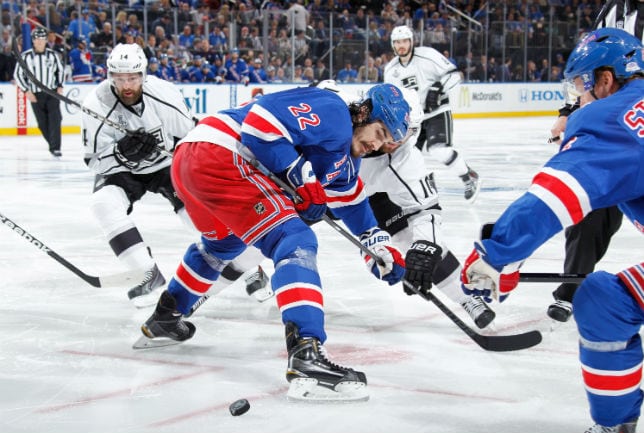
The NHL announced Monday that it will adopt the pre-season faceoff hashmark distance of five feet, seven inches for the the regular season. If the officials actually call faceoff violations and penalize teams for it, the rule could have a big effect.
 Will NHL's new faceoff configuration lead to more goals, fewer fights?
Will NHL's new faceoff configuration lead to more goals, fewer fights?Monday was a busy day in the hockey world. With only two sleeps left until the start of the regular season, the Ryan Johansen signing and a couple of teams cutting loose their dancing bears, there was a lot of grist for the mill.
So it’s understandable that the league’s announcement that it would increase the distance between the hash marks for the offensive/defensive zone faceoff circles would fly under the radar a little bit. It’s not one of those sexy news items that allow people to jump to instant conclusions, such as declaring the enforcer in the NHL obsolete after seeing teams such as the Toronto Maple Leafs and Philadelphia Flyers go into the season with one on their rosters. Nice thought, but these guys seem to be the NHL’s version of the cockroach and I, for one, remain skeptical that we’ve seen the last of them.
Which leads us to the new wrinkle for faceoffs, which was passed overwhelmingly by the league’s board of governors Monday after receiving endorsement from both the GMs and the competition committee. It will see the league adopt the hash marks it used as an experiment during the pre-season. Those lines will move from three feet apart to the International Ice Hockey Federation standard of five feet, seven inches. So when you take into account the two-inch width of each line, players will be almost six feet away from one another to drop the puck in the end zones.
Will that be enough to change the game significantly? Not even Colin Campbell, the NHL’s director of hockey operations, can say for sure. Yes, it was used in the pre-season, but Campbell acknowledges that nobody in hockey is focused on the rule changes during the pre-season. “Nobody came to us and said, ‘Gee, the hashmarks are really working,’ “ Campbell said. “It’s something you have to wait and see. When the games mean something, coaches can tell you if another team’s bench is three inches longer than his, but during the pre-season, nobody really cares. But before we did this, we talked with (Mike) Babcock, (Ken) Hitchcock, (Claude) Julien, (Doug) Armstrong, (Steve) Yzerman, all guys who were at the Olympics. And they really liked the separation.”
Campbell said the league just spoke with linesmen and told them there has to be a high level of vigilance early on with offenders. “Guys are going to push it, we know that,” Campbell said. “But nobody wants to get a penalty for encroaching on the hashmarks.”
And that’s where this rule will succeed or fail, with the officials on the ice. It’s rarely called, but officials have the latitude to give the offending team a bench minor penalty for “Delay of game – faceoff violation” if the team commits two or more faceoff violations on the same draw. Going over the hashmark is considered a faceoff violation, so teams would basically be able to get one warning before the officials would have the power to penalize them.
As a kid who watched hockey in the 1970s, I recall a time when there was just one red line to separate the wingers on the faceoffs. As players got bigger and faceoffs became more important, it became two and now the players will have enough distance between them that they won’t be able to jostle. And as if faceoffs weren’t already important enough, this new rule will, I think, place even more importance on winning the draw and gaining possession of the puck.
If the attacking team wins the faceoff, its forwards now have a little more room to get into a scoring position. And if the defensive team wins the faceoff, it will be more difficult for the attacking team to regain control of the puck because defenders will have a split second more to handle it and make a decision what to do with the puck.
It could lead to more offensive chances if the attacking team can win the draw, but where the impact will likely be more dramatic is on the power play and during 4-on-4 (or 4-on-3) play in overtime. By making it more difficult for defenders to tie up forwards, and creating just a couple of inches more distance from the checking forward and the men at the points, it could end up making a difference.
Another byproduct could be that if you keep the few enforcers that are left three more inches away from one another, it might cut down on the number of fights. But again, that might be a stretch. If two guys are out there with the sole intention of fighting, all they’re going to have to do now is say, “Wanna go?” just a little bit louder.
But it will undoubtedly cut down on the needless scrums that occur in the faceoff circle prior to the draw. Today’s NHL is all about game flow and this certainly helps in that regard, even if it means a few annoying bench minors early in the season just to show the players and coaches that the NHL means business.

